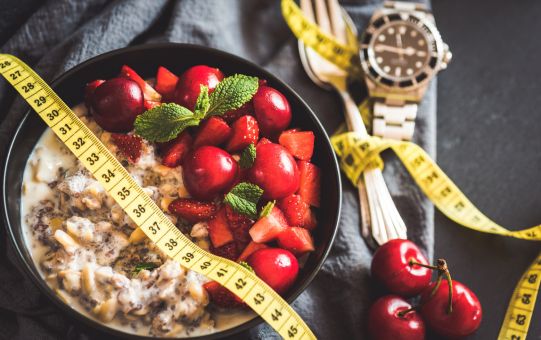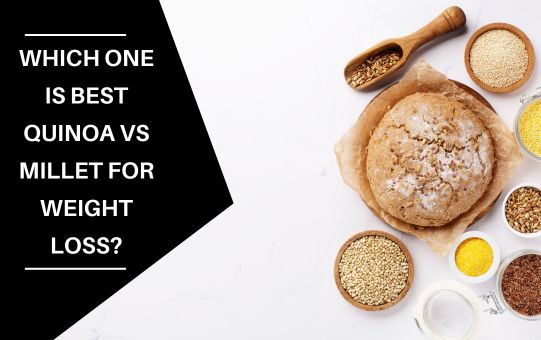Discover the ideal grain for weight loss by quinoa and millet that impact shedding weight. Choose wisely Which One Is Best Quinoa Vs Millet For Weight Loss journey.
Which one is best quinoa vs millet for weight loss? When it comes to weight loss, choosing the right foods plays a vital role. Among the various grains available, quinoa and millet have gained significant attention for their potential weight loss benefits. But which one is truly the champion in the ring?
In this comprehensive article, we will dive deep into the world of quinoa and millet, examining their nutritional profiles, health benefits, and impact on weight loss. By the end, you’ll have a clear understanding of which grain reigns supreme in the battle for weight loss supremacy.
Contents
What is Quinoa?
Quinoa, pronounced “keen-wah,” originated in the Andean region of South America and has been cultivated for thousands of years. It is often referred to as a “superfood” due to its exceptional nutritional content. Quinoa is rich in protein, fiber, and essential vitamins and minerals.
Additionally, it is gluten-free, making it an excellent choice for individuals with gluten sensitivities or celiac disease.
The health benefits of quinoa are vast. Firstly, quinoa is a complete protein source, containing all nine essential amino acids that our bodies need. This makes it an ideal option for vegetarians and vegans looking to increase their protein intake.
Quinoa also boasts high levels of fiber, promoting digestion, regulating blood sugar levels, and providing a feeling of fullness, which can aid in weight loss efforts.
What is Millet?
Millet has a long history and is believed to have been cultivated for over 10,000 years. It is a group of small-seeded grasses that are highly adaptable and can be grown in various climates.
Millet is widely consumed in Africa, Asia, and parts of Europe. Like quinoa, millet is gluten-free, making it suitable for individuals with gluten intolerances or celiac disease.
Millet offers several nutritional benefits as well. It is a rich source of magnesium, phosphorus, and B vitamins, which are essential for energy production and overall well-being.
Millet is also high in fiber, supporting digestive health and aiding in weight management. Its natural composition helps regulate cholesterol levels and maintain a healthy heart.
Which One Is Best Quinoa Vs Millet For Weight Loss?
Both quinoa and millet can be beneficial for weight loss, but the choice ultimately depends on individual preferences and dietary needs.
Quinoa is a highly nutritious grain-like seed that is rich in protein, fiber, and essential amino acids. Its high fiber content promotes satiety and helps control appetite, making it a satisfying option for weight loss.
On the other hand, millet is a gluten-free grain that offers a good source of B vitamins and dietary fiber. Its high fiber content aids in digestion and promotes a feeling of fullness, which can contribute to weight loss efforts.
Millet is also low in fat and calories, making it a suitable choice for individuals looking to reduce calorie intake.

Comparison of Quinoa and Millet for Weight Loss
When considering quinoa vs. millet for weight loss, several factors come into play. Let’s examine these grains from various perspectives to help you make an informed choice:
Caloric Content and Macronutrient Composition:
Both quinoa and millet are relatively low in calories compared to other grains. Quinoa contains approximately 120 calories per cooked cup, while millet has around 207 calories per cooked cup. However, it’s important to note that these calorie counts can vary depending on cooking methods and portion sizes.
In terms of macronutrient composition, quinoa and millet offer different profiles. Quinoa is higher in protein, with around 8 grams per cooked cup, compared to millet’s 6 grams per cooked cup. Protein is essential for maintaining muscle mass and supporting satiety, making quinoa a favorable option for those aiming to lose weight.
Fiber Content and Satiety:
Both quinoa and millet are excellent sources of dietary fiber. Quinoa provides approximately 5 grams of fiber per cooked cup, while millet offers around 2 grams per cooked cup.
Fiber plays a crucial role in promoting feelings of fullness, reducing cravings, and aiding in digestion. The higher fiber content in quinoa may help you stay satisfied for longer periods and manage your weight more effectively.
Glycemic Index and Blood Sugar Control:
The glycemic index (GI) measures how quickly carbohydrates in food raise blood sugar levels. Quinoa has a lower GI compared to millet, which means it has a slower and steadier impact on blood glucose levels.
This characteristic is beneficial for weight management as it helps regulate hunger and prevents sudden spikes and crashes in energy levels. Millet, although having a slightly higher GI, is still considered a good choice for individuals looking to control blood sugar levels.
| Aspect | Quinoa | Millet |
| Nutritional Value | Rich in protein, fiber, and essential amino acids | Good source of B vitamins and dietary fiber |
| Calorie Content | Approximately 120-130 calories per 1/2 cup (cooked) | Approximately 100-120 calories per 1/2 cup (cooked) |
| Carbohydrates | Contains complex carbohydrates with a low glycemic index | Contains complex carbohydrates |
| Protein Content | Higher protein content compared to most grains | Moderate protein content |
| Fiber Content | High fiber content, aids in satiety and digestion | Contains dietary fiber |
| Fat Content | Low in fat | Low in fat |
| Cooking Time | Takes approximately 15-20 minutes to cook | Takes approximately 20-25 minutes to cook |
| Weight Loss Potential | High fiber and protein content promote satiety and help control appetite | High fiber content aids in digestion and promotes a feeling of fullness |
Micronutrient Content and Nutritional Value:
Quinoa and millet are both rich in vitamins and minerals, but their specific nutrient profiles differ. Quinoa is particularly high in magnesium, iron, and zinc, which are essential for energy production, immune function, and overall health.
Millet, on the other hand, is a good source of phosphorus, manganese, and B vitamins. Including a variety of grains in your diet can ensure a diverse nutrient intake and support weight loss efforts.
Quinoa and Millet Recipes for Weight Loss
Incorporating quinoa and millet into your weight loss journey can be both delicious and nutritious. Here are some recipe ideas to inspire you:
Quinoa Recipes:
Quinoa Salad with Roasted Vegetables: Cook quinoa and toss it with roasted vegetables like bell peppers, zucchini, and cherry tomatoes. Add a drizzle of olive oil, lemon juice, and fresh herbs for a refreshing and satisfying salad.
Quinoa Stuffed Bell Peppers:
Cut the tops off bell peppers, remove the seeds, and stuff them with a mixture of cooked quinoa, lean protein like grilled chicken or tofu, and vegetables. Bake until the peppers are tender and enjoy a flavorful and low-calorie meal.

Millet Recipes:
Millet Breakfast Porridge:
Cook millet with your choice of milk (dairy or plant-based), cinnamon, and a sweetener like honey or maple syrup. Top it with fresh fruits, nuts, and seeds for a nourishing and filling breakfast.
Millet and Vegetable Stir-Fry:
Stir-fry millet with an assortment of colorful vegetables, such as broccoli, carrots, and peas. Add soy sauce or your favorite seasoning for a quick and healthy meal option.
Read Also>>> which is better ragi vs millet for weight loss?
Which One Should You Choose for Weight Loss?
Ultimately, the choice between quinoa and millet for weight loss depends on your personal preferences, dietary needs, and goals. Both grains offer numerous health benefits and can contribute to a balanced and nutritious diet.
Consider incorporating a variety of grains, including quinoa and millet, into your meals to reap the diverse benefits they provide. Variety not only ensures a broader range of nutrients but also adds excitement and flavor to your meals.
When selecting grains for weight loss, it’s important to consider portion sizes and overall calorie intake. While quinoa is lower in calories and higher in protein, millet offers its unique set of nutritional advantages. It’s beneficial to consult with a healthcare professional or a registered dietitian who can provide personalized recommendations based on your specific needs and goals.
Incorporating quinoa and millet into your weight loss plan is just one piece of the puzzle. Remember to focus on overall balanced eating, regular physical activity, and a healthy lifestyle. Sustainable weight loss is a gradual process that requires consistency and a holistic approach.
Conclusion
both quinoa and millet are nutritious options that can support your weight loss journey. Quinoa is known for its protein content, fiber richness, and complete amino acid profile. Millet, on the other hand, offers a good source of minerals and B vitamins while aiding in digestion and promoting heart health.
So why not embrace the best of both worlds? Experiment with different recipes, explore the versatility of quinoa and millet and discover what works best for your taste buds and weight loss goals. Remember, it’s not about choosing one over the other; it’s about finding a balance that suits your lifestyle and nourishes your body.
Read Also>>> How to Add Millet to Bread?
FAQs
Can I Consume Quinoa Or Millet If I Have Gluten Intolerance?
Yes, both quinoa and millet are gluten-free grains and can be safely consumed by individuals with gluten intolerance or celiac disease.
Do Quinoa And Millet Aid In Weight Loss?
Yes, both grains can support weight loss efforts due to their high fiber content, protein, and nutrient profiles. They promote satiety and provide essential nutrients while being relatively low in calories.
Are There Any Potential Allergies Or Side Effects Associated With Quinoa Or Millet?
Allergic reactions to quinoa or millet are rare. However, if you experience any adverse effects after consumption, it’s best to consult a healthcare professional.
Can I Include Quinoa Or Millet In A Low-Carb Diet?
While quinoa and millet contain carbohydrates, they are nutrient-dense and offer valuable health benefits. If you follow a low-carb diet, it’s essential to consider portion sizes and incorporate these grains mindfully.
Are Quinoa And Millet Suitable For Vegetarian Or Vegan Diets?
Yes, both quinoa and millet are excellent sources of plant-based protein and can be a valuable addition to vegetarian or vegan diets.

